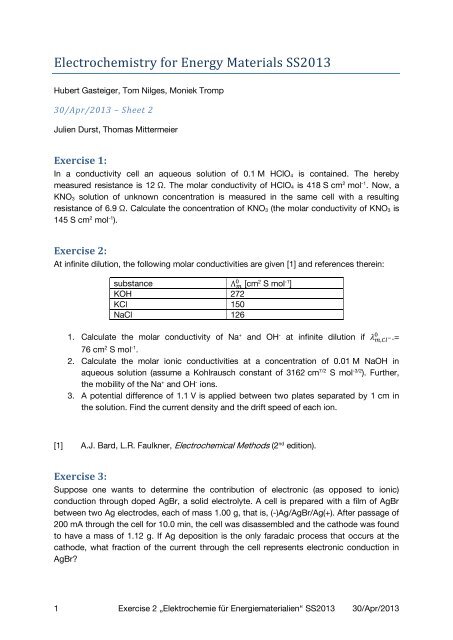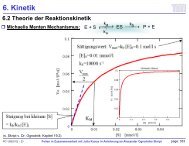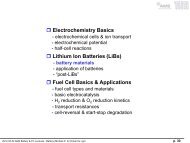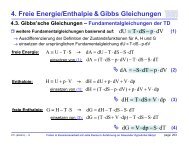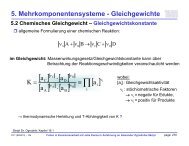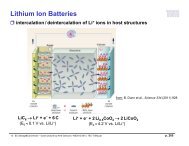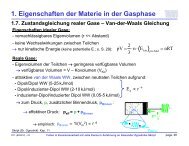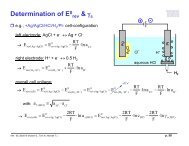Electrochemistry for Energy Materials SS2013
Electrochemistry for Energy Materials SS2013
Electrochemistry for Energy Materials SS2013
You also want an ePaper? Increase the reach of your titles
YUMPU automatically turns print PDFs into web optimized ePapers that Google loves.
<strong>Electrochemistry</strong> <strong>for</strong> <strong>Energy</strong> <strong>Materials</strong> <strong>SS2013</strong><br />
Hubert Gasteiger, Tom Nilges, Moniek Tromp<br />
30/Apr/2013 – Sheet 2<br />
Julien Durst, Thomas Mittermeier<br />
Exercise 1:<br />
In a conductivity cell an aqueous solution of 0.1 M HClO 4 is contained. The hereby<br />
measured resistance is 12 Ω. The molar conductivity of HClO 4 is 418 S cm 2 mol -1 . Now, a<br />
KNO 3 solution of unknown concentration is measured in the same cell with a resulting<br />
resistance of 6.9 Ω. Calculate the concentration of KNO 3 (the molar conductivity of KNO 3 is<br />
145 S cm 2 mol -1 ).<br />
Exercise 2:<br />
At infinite dilution, the following molar conductivities are given [1] and references therein:<br />
substance [cm 2 S mol -1 ]<br />
KOH 272<br />
KCl 150<br />
NaCl 126<br />
1. Calculate the molar conductivity of Na + and OH - at infinite dilution if .=<br />
76 cm 2 S mol -1 .<br />
2. Calculate the molar ionic conductivities at a concentration of 0.01 M NaOH in<br />
aqueous solution (assume a Kohlrausch constant of 3162 cm 7/2 S mol -3/2 ). Further,<br />
the mobility of the Na + and OH - ions.<br />
3. A potential difference of 1.1 V is applied between two plates separated by 1 cm in<br />
the solution. Find the current density and the drift speed of each ion.<br />
[1] A.J. Bard, L.R. Faulkner, Electrochemical Methods (2 nd edition).<br />
Exercise 3:<br />
Suppose one wants to determine the contribution of electronic (as opposed to ionic)<br />
conduction through doped AgBr, a solid electrolyte. A cell is prepared with a film of AgBr<br />
between two Ag electrodes, each of mass 1.00 g, that is, (-)Ag/AgBr/Ag(+). After passage of<br />
200 mA through the cell <strong>for</strong> 10.0 min, the cell was disassembled and the cathode was found<br />
to have a mass of 1.12 g. If Ag deposition is the only faradaic process that occurs at the<br />
cathode, what fraction of the current through the cell represents electronic conduction in<br />
AgBr<br />
1 Exercise 2 „Elektrochemie für Energiematerialien“ <strong>SS2013</strong> 30/Apr/2013
Exercise 4:<br />
Transference numbers are often measured by the Hittorf method as illustrated in this<br />
problem. Consider the three-compartment cell:<br />
L С R<br />
(-)Ag/AgNO 3(0.100 M)//AgNO 3(0.100 M)//AgNO 3(0.100 M)/Ag(+)<br />
where the double slashes (//) signify sintered glass disks that divide the compartments and<br />
prevent mixing, but not ionic movement. The volume of AgNO3 solution in each<br />
compartment (L, C, R) is 25.00 ml. An external power supply is connected to the cell with<br />
the polarity shown, and current is applied until 96.5 С have passed, causing Ag to deposit<br />
on the left Ag electrode and Ag to dissolve from the right Ag electrode.<br />
1. How many grams of Ag have deposited on the left electrode How many mmol of Ag<br />
have deposited<br />
2. If the transference number <strong>for</strong> Ag + were 1.00 (i.e., t Ag+ = 1.00, t NO3- = 0.00), what<br />
would the concentrations of Ag + be in the three compartments after electrolysis<br />
3. Suppose the transference number <strong>for</strong> Ag + were 0.00 (i.e., t Ag+ = 0.00, t NO3- = 1.00),<br />
what would the concentrations of Ag + be in the three compartments after<br />
electrolysis<br />
4. In an actual experiment like this, it is found experimentally that the concentration of<br />
Ag + in the anode compartment R has increased to 0.121 M. Calculate t Ag+ and t NO3.<br />
2 Exercise 2 „Elektrochemie für Energiematerialien“ <strong>SS2013</strong> 30/Apr/2013


